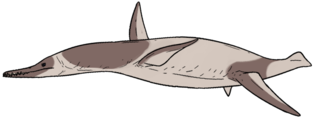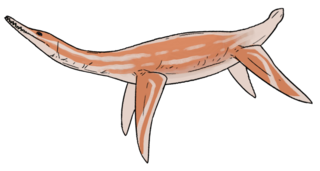
Cryptoclidus is a genus of plesiosaur reptile from the Middle Jurassic period of England, France, and Cuba.

Futabasaurus is a genus of plesiosaur from the Late Cretaceous of Fukushima, Japan. It was described and named in 2006, and was assigned to the family Elasmosauridae. The genus contains one species, F. suzukii.

Hydrotherosaurus is an extinct genus of elasmosaurid plesiosaur from the Upper Cretaceous Moreno Formation of Fresno County, California, USA. The only known species, H. alexandrae, was named for Annie Montague Alexander in 1943 by Samuel Paul Welles.

Microcleidus is an extinct genus of sauropterygian reptile belonging to the Plesiosauroidea. The species has 40 neck vertebrae and a short tail of 28 vertebrae. Fossils of the genus have been found in France, the Posidonia Shale in Germany and Luxembourg, and the Alum Shale Formation of England.
Yuzhoupliosaurus is an extinct genus of plesiosaur from the Middle Jurassic of China. The genus is known only from a lower jaw, a vertebra, and fragments of a pectoral girdle. It is believed this genus lived in fresh water.

Scanisaurus is a dubious genus of plesiosaur that lived in what is now Sweden and Russia during the Campanian stage of the Late Cretaceous period. The name Scanisaurus means "Skåne lizard", Skåne being the southernmost province of Sweden, where a majority of the fossils referred to the genus have been recovered. The genus contains one species, S. nazarowi, described in 1911 by Nikolay Bogolyubov as a species of Cimoliasaurus based on a single vertebral centrum discovered near Orenburg, Russia.

Archaeonectrus is an extinct genus of pliosaur from the Early Jurassic (Sinemurian) of what is now southeastern England. The type species is Archaeonectrusrostratus, first named by Sir Richard Owen in 1865, which was moved to its own genus by N.I. Novozhilov in 1964. It was a relatively small plesiosaur, measuring 3.4–3.67 m (11.2–12.0 ft) long.
Leurospondylus is an extinct genus of plesiosaur from the Horseshoe Canyon Formation of Canada whose family is currently disputed, but is suggested to be Elasmosauridae.

Polycotylus is a genus of plesiosaur within the family Polycotylidae. The type species is P. latippinis and was named by American paleontologist Edward Drinker Cope in 1869. Eleven other species have been identified. The name means 'much-cupped vertebrae', referring to the shape of the vertebrae. It lived in the Western Interior Seaway of North America toward the end of the Cretaceous. One fossil preserves an adult with a single large fetus inside of it, indicating that Polycotylus gave live birth, an unusual adaptation among reptiles.

Hauffiosaurus is an extinct genus of Early Jurassic pliosaurid plesiosaur known from Holzmaden of Germany and from Yorkshire of the United Kingdom. It was first named by Frank Robin O’Keefe in 2001 and the type species is Hauffiosaurus zanoni. In 2011, two additional species were assigned to this genus: H. longirostris and H. tomistomimus.

Georgiasaurus is an extinct genus of plesiosaur from the Late Cretaceous of Russia. Otschev originally named the specimen Georgia, but that name was preoccupied. Originally a complete skeleton, the specimen was damaged in preparation of the quarry stone.

Eretmosaurus is an extinct genus of plesiosaur from the Early and Middle Jurassic of England and Russia. Two species are known: E. rugosus and E. dubius.

Eopolycotylus is a genus of polycotylid plesiosaur known from the Cenomanian-age Tropic Shale of Utah.

Sthenarosaurus is an extinct genus of rhomaleosaurid pliosauroid discovered in the Toarcian-aged 'Main Alum Shale' in Whitby, England. The type species, Sthenarosaurus dawkinsi, was named and described in 1909 by D. M. S. Watson. The type specimen is MMUM LL 8023, a set of postcrania discovered in Whitby. Other indeterminate specimens are known, including a pectoral girdle described in 1911. Plesiosaurian fossils were acquired for the Manchester Museum by William Boyd Dawkins who is honoured by the specific name.

Seeleyosaurus is an extinct genus of plesiosaur from Germany and possibly also Russia.

Palmulasaurus is a genus of polycotylid plesiosaur from the Turonian Tropic Shale of Utah. It was originally described as Palmula, but the name was occupied by a genus of Cretaceous foraminifer first described in 1833.
Alexeyisaurus is an extinct genus of possible plesiosaur known from the upper Triassic of Wilczek Formation, Wilczek Land, of Franz Josef Land, Russia. It was first named by A. G. Sennikov and M. S. Arkhangelsky in 2010 and the type species is Alexeyisaurus karnoushenkoi. While considered an elasmosaur in the initial publication It has been described as a "partial, poorly preserved, and undiagnostic sauropterygian skeleton" in subsequent publications.
Abyssosaurus is an extinct genus of cryptoclidid plesiosaur known from the Early Cretaceous of Chuvash Republic, western Russia. It possessed a shortened skull, and it has been suggested that it primarily inhabited the bathyal zone.

This timeline of plesiosaur research is a chronologically ordered list of important fossil discoveries, controversies of interpretation, taxonomic revisions, and cultural portrayals of plesiosaurs, an order of marine reptiles that flourished during the Mesozoic Era. The first scientifically documented plesiosaur fossils were discovered during the early 19th century by Mary Anning. Plesiosaurs were actually discovered and described before dinosaurs. They were also among the first animals to be featured in artistic reconstructions of the ancient world, and therefore among the earliest prehistoric creatures to attract the attention of the lay public. Plesiosaurs were originally thought to be a kind of primitive transitional form between marine life and terrestrial reptiles. However, now plesiosaurs are recognized as highly derived marine reptiles descended from terrestrial ancestors.

Jucha is an extinct genus of plesiosaur found in the Hauterivian Klimovka Formation of Russia. The type species, J. squalea, was one of the basalmost and oldest definitive elasmosaurs known to date.















